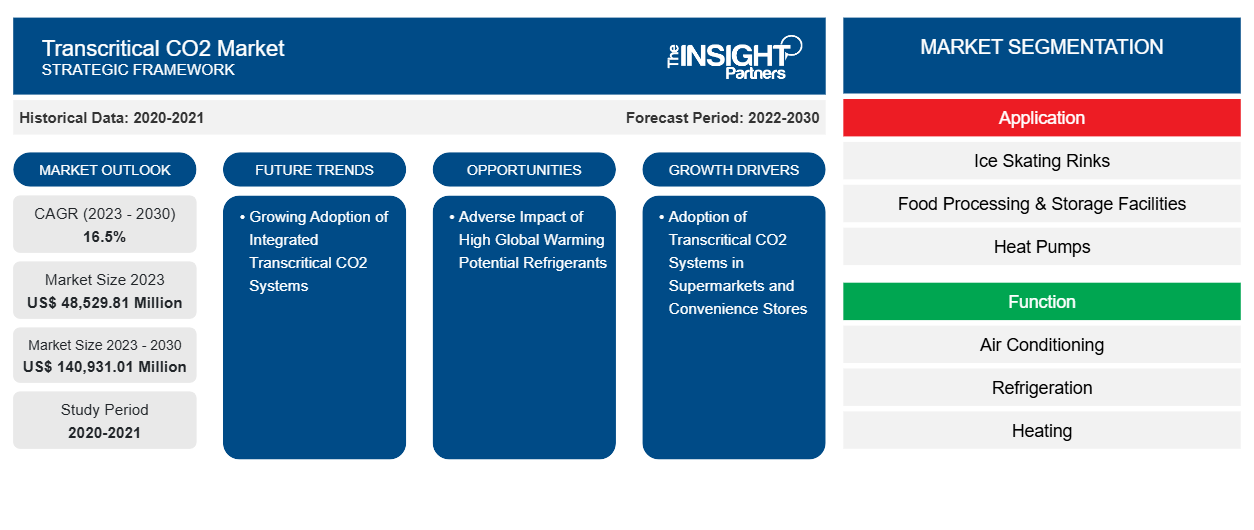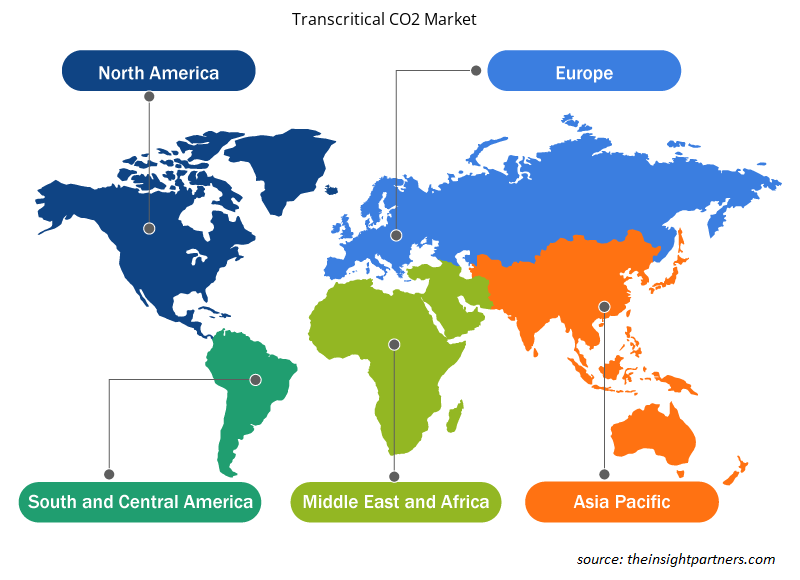トランスクリチカルCO2市場規模は、2024年の541.5億米ドルから2031年には1,569.9億米ドルに達すると予測されています。市場は2025年から2031年にかけて年平均成長率(CAGR)16.8%を記録すると予測されています。廃棄物からリサイクルされたCO2を冷凍用途に活用することは、今後数年間で市場に新たなトレンドをもたらす可能性が高いでしょう。
トランスクリチカルCO2市場分析
トランスクリティカルCO2システムは、環境への影響を抑えながら安定した冷却を実現するため、主に冷蔵施設に適しています。冷凍食品や生鮮食品の需要の急増に伴うコールドチェーン産業の急速な成長は、冷却用途におけるこれらのシステムの必要性を高める大きな要因となっています。トランスクリティカルCO2システムの革新は、高温環境下での効率低下など、これまでの課題のいくつかを克服するのに役立っています。エジェクター技術や並列圧縮などの開発により、温暖な気候におけるトランスクリティカルシステムの性能が向上し、世界中で適用範囲が広がっています。
トランスクリチカルCO2市場概要
トランスクリティカルCO2市場は、トランスクリティカルシステムにおける冷媒としての二酸化炭素(CO2)の応用を中心に展開しています。トランスクリティカルCO2システムは、CO2の臨界圧力以上で機能するため、冷蔵や暖房などの用途において極めて効率的です。これらのシステムは、環境に優しく、費用対効果が高く、規制遵守が可能なことから人気が高まっており、地球温暖化係数(GWP)の高い合成冷媒の段階的廃止という目標にも合致しています。アジア太平洋、アフリカ、南米などの発展途上地域では都市化が継続的に進んでおり、インドやブラジルではスーパーマーケットの普及率が増加しており、トランスクリティカルCO2システム導入の大きなチャンスが生まれています。これらの地域の政府も、天然冷媒の適用を奨励する環境政策を受け入れています。小売や食品加工に加え、製薬、化学処理、データセンターなどの業界でも、冷却ニーズに対応するためにトランスクリティカルCO2システムが活用されています。
このレポートの一部、国レベルの分析、Excelデータパックなど、あらゆるレポートを無料でカスタマイズできます。また、スタートアップや大学向けのお得なオファーや割引もご利用いただけます。
トランスクリチカルCO2市場:戦略的洞察

-
このレポートの主要な市場動向を入手してください。この無料サンプルには、市場動向から見積もりや予測に至るまでのデータ分析が含まれます。
トランスクリチカルCO2市場の推進要因と機会
北米とヨーロッパのデータセンターにおける省エネ空調の需要増加
データセンター数の増加は、トランスクリティカルCO2市場に恩恵をもたらしています。データセンターの運用における膨大なエネルギー消費量を考慮すると、設計エンジニアはこれらの施設向けに信頼性が高くエネルギー効率の高い空調システムを提供する必要があります。ヨーロッパには、フランクフルト、ロンドン、アムステルダム、パリ、ダブリンといった主要ハブを擁する、活気のあるデータセンター産業の大きな存在感があります。ミラノ、ワルシャワ、ベルリンといった新興市場も急速に拡大しています。デジタルサービスへの依存度が高まるにつれ、データセンターはヨーロッパのデジタル経済のバックボーンになりつつあります。堅牢なネットワークで相互接続されたこれらのデータハブは、インターネットへのシームレスなアクセスを可能にし、最終的には医療、ライフサイエンス、銀行など、さまざまな重要な分野の業務をサポートしています。この地域のデータセンター事業者は、EUの厳格な炭素排出規制を受けて、持続可能性をますます優先しています。米国では、ハイパースケール事業者の注目すべき活動により、テキサスが成長著しいデータセンターハブの1つとなっています。米国西部地域はデータセンターの先進市場としての地位を確立しており、アイダホ州、オレゴン州、カリフォルニア州、ユタ州などの主要な場所に Meta (旧 Facebook)、Google、Microsoft などの大手企業がすべて集まっています。
2024年3月、キャリアは、水冷式フリークーリングシステムと可変速インバータドライブを組み合わせたAquaForce 30XF空冷スクリューチラーを発表しました。これは、データセンター向けに最大約50%のエネルギー効率を実現するように設計されています。HFCを使用する冷媒は、コンピュータールーム空調(CRAC)ユニット、チラー、一部のインロー冷却システムなど、いくつかのデータセンター機器で使用されています。いくつかの大規模データセンター事業者は、チラーへの依存を減らす努力をしており、代替として空調ユニットと外気を利用するフリークーリング戦略に移行しています。冷媒は、フリークーリングが実用的ではない温暖な気候のハイパースケールおよびサービスプロバイダーのデータセンターをサポートするために、エンタープライズデータセンターで一般的に使用されています。CO2の形態の自然冷媒は、産業用および商業用の冷却システムに広く使用されています。したがって、エネルギー効率の高い空調および冷却システムの需要の高まりは、トランスクリティカルCO2市場を後押ししています。
食品・飲料および医薬品業界におけるCO2冷媒の重要性の高まり
食品・飲料業界では、冷媒は主に食品・飲料製品の保存のための温度管理環境を維持するために利用されています。米国では、都市化の進行、可処分所得の増加、そして多忙なライフスタイルに伴い、加工食品、缶詰食品、そして手軽に調理できる食品の需要が高まっています。さらに、その美味しさと調理の簡便さから、国内の若者の間で人気が高まっています。缶詰食品やインスタント食品は、その美味しさを維持するために適切な保管施設が必要です。加工食品は、適切に保存しないと数日または数週間で腐敗する可能性が高くなります。加工食品や缶詰食品の賞味期限を延ばすには、最適な温度と適切な保管条件が不可欠であり、これが冷媒の需要につながります。そのため、スーパーマーケットやコンビニエンスストアは、生鮮食品の保管に冷蔵システムに依存しているため、環境に大きな影響を与えています。持続可能性と環境責任の重要性の高まりは、これらの冷却システムに関連する二酸化炭素排出量と温室効果ガス排出量を削減する必要性を強調しています。このように、高GWP冷媒からの移行ニーズは、トランスクリチカルCO2システムプロバイダーにとって成長機会となります。トランスクリチカルCO2システムは、従来の冷媒に伴う環境負荷を軽減し、持続可能性目標の達成に貢献するため、持続可能なソリューションへの需要は、今後もトランスクリチカルCO2市場に利益をもたらし続けるでしょう。
トランスクリチカルCO2市場レポートのセグメンテーション分析
トランスクリチカル CO2 市場分析の導出に貢献した主なセグメントは、アプリケーションと機能です。
- 用途別に見ると、市場はアイススケートリンク、食品加工・保管施設、ヒートポンプ、スーパーマーケット・コンビニエンスストア、その他に分類されています。2024年には、スーパーマーケット・コンビニエンスストアセグメントが市場を席巻しました。
- 機能別に見ると、市場は空調、冷蔵、暖房に分類されます。2024年には冷蔵セグメントが市場を支配しました。
トランスクリチカルCO2市場シェアの地域別分析
トランスクリチカルCO2市場は、北米、欧州、アジア太平洋(APAC)、中東・アフリカ(MEA)、中南米(SAM)の5つの主要地域に区分されています。2024年には北米が市場を席巻し、欧州とアジア太平洋がそれに続きます。
トランスクリチカルCO2市場は、北米、ヨーロッパ、アジア太平洋(APAC)、中東およびアフリカ(MEA)、南米および中米の5つの主要地域に分割されています。2024年には、ヨーロッパが大きな収益シェアで市場をリードし、アジア太平洋がそれに続きました。さらに、北米は2025年から2031年にかけてトランスクリチカルCO2市場で最高のCAGRを記録すると予想されています。ヨーロッパのトランスクリチカルCO2市場は、ドイツ、フランス、イタリア、英国、ロシア、その他のヨーロッパに細分化されています。この地域では冷蔵施設の数が増加しています。欧州冷蔵・物流協会(ECSLA)によると、ヨーロッパにはさまざまな商品を保管するための60,000 m3を超える冷蔵容量を持つ何千もの冷蔵店があります。さらに、ヨーロッパ諸国は、フッ素化温室効果ガスとオゾン層破壊物質の排出を厳しく管理するための規則と規制を実施しています。したがって、F-ガス法とHFC段階的廃止計画により、欧州のトランスクリチカルCO2システム市場は今後著しい速度で成長すると予想されます。
トランスクリチカルCO2市場の地域別分析
Insight Partnersのアナリストは、予測期間を通じてトランスクリチカルCO2市場に影響を与える地域的な動向と要因を詳細に解説しています。本セクションでは、北米、ヨーロッパ、アジア太平洋、中東・アフリカ、中南米におけるトランスクリチカルCO2市場のセグメントと地域についても解説します。

- トランスクリティカルCO2市場の地域別データを入手
トランスクリチカルCO2市場レポートの範囲
| レポート属性 | 詳細 |
|---|---|
| 2024年の市場規模 | 541億5000万米ドル |
| 2031年までの市場規模 | 1,569億9,000万米ドル |
| 世界のCAGR(2025年~2031年) | 16.8% |
| 履歴データ | 2021-2023 |
| 予測期間 | 2025~2031年 |
| 対象セグメント |
アプリケーション別
|
| 対象地域と国 |
北米
|
| 市場リーダーと主要企業の概要 |
|
トランスクリティカルCO2市場のプレーヤー密度:ビジネスダイナミクスへの影響を理解する
トランスクリチカルCO2市場は、消費者の嗜好の変化、技術の進歩、製品メリットへの認知度の向上といった要因によるエンドユーザーの需要増加に牽引され、急速に成長しています。需要の増加に伴い、企業は製品ラインナップの拡充、消費者ニーズへの対応のためのイノベーション、そして新たなトレンドの活用を進めており、これが市場の成長をさらに加速させています。
市場プレーヤー密度とは、特定の市場または業界内で事業を展開する企業または会社の分布を指します。これは、特定の市場空間における競合企業(市場プレーヤー)の数が、その市場規模または市場価値全体と比較してどれだけ多いかを示します。
トランスクリチカル CO2 市場で事業を展開している主要企業は次のとおりです。
- TEKO Gesellschaft fur Kaltetechnik GmbH
- ボルチモア・エアコイル社
- BITZER Kuhlmaschinenbau GmbH
- キャリアグローバル株式会社
- ダンフォスAS
- ハスマン社
免責事項:上記の企業は、特定の順序でランク付けされているわけではありません。

- トランスクリチカルCO2市場のトップキープレーヤーの概要を入手
トランスクリチカルCO2市場のニュースと最近の動向
トランスクリチカルCO2市場は、主要な企業出版物、協会データ、データベースなどを含む一次調査および二次調査に基づく定性・定量データの収集によって評価されます。市場における主要な動向をいくつか以下に挙げます。
- CoolSysはUniversal Refrigeration, Inc.の買収を発表しました。(出典:CoolSys、プレスリリース、2025年6月)
- メリーランド州に拠点を置く自然冷媒システムおよびコンポーネントのOEMメーカーであるEvapcoは、カリフォルニア州ロングビーチで3月12日から15日まで開催されたIIARカンファレンス&エキスポにおいて、低充填アンモニア(ペントハウス冷蔵庫およびチラー)とトランスクリティカルCO2パッケージシステムを展示しました。(出典:Evapco、プレスリリース、2023年4月)
- エマソン(米国)は、業界初のトランスクリティカルCO2スクリューコンプレッサーの発売により、CO2圧縮ポートフォリオの拡大を発表しました。(出典:エマソン、プレスリリース、2023年3月)
- パナソニック傘下のハスマン社は、屋外設置型CO2コンデンシングユニット(OCU)を追加し、CO2冷凍システム製品のラインナップを拡充します。OCUは中温または低温用途向けに設計されており、小売店の冷蔵設備に汎用性と効率性をもたらします。(出典:ハスマン社、プレスリリース、2024年12月)
トランスクリチカルCO2市場レポートの対象範囲と成果物
「トランスクリチカル CO2 市場規模と予測 (2025 ~ 2031 年)」では、以下の分野を網羅した市場の詳細な分析を提供しています。
- 対象範囲に含まれるすべての主要市場セグメントについて、世界、地域、国レベルでのトランスクリチカルCO2市場規模と予測
- トランスクリチカルCO2市場の動向、および推進要因、制約、主要な機会などの市場動向
- 詳細なPEST分析とSWOT分析
- 主要な市場動向、世界および地域の枠組み、主要プレーヤー、規制、最近の市場動向を網羅したトランスクリチカルCO2市場分析
- トランスクリチカルCO2市場の市場集中、ヒートマップ分析、主要プレーヤー、最近の動向を網羅した業界の展望と競争分析
- 詳細な企業プロフィール
- 過去2年間の分析、基準年、CAGRによる予測(7年間)
- PEST分析とSWOT分析
- 市場規模価値/数量 - 世界、地域、国
- 業界と競争環境
- Excel データセット
最新レポート
関連レポート
お客様の声
購入理由
- 情報に基づいた意思決定
- 市場動向の理解
- 競合分析
- 顧客インサイト
- 市場予測
- リスク軽減
- 戦略計画
- 投資の正当性
- 新興市場の特定
- マーケティング戦略の強化
- 業務効率の向上
- 規制動向への対応






















 無料サンプルを入手 - トランスクリチカルCO2市場
無料サンプルを入手 - トランスクリチカルCO2市場